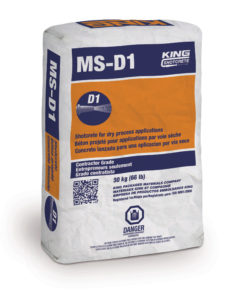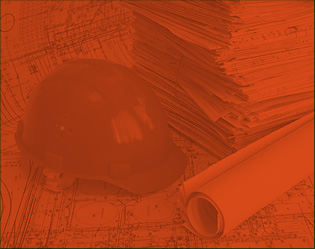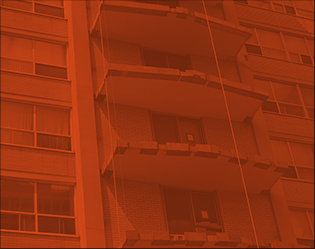Can Dry-Mix Shotcrete Be Air-Entrained?
MS-D1
• Air-entrainment provides superior resistance to freeze-thaw cycling and salt-scaling resistance.
• Improved adhesive and cohesive plastic properties.
• Significantly reduced rebound, resulting in lower material usage.
Can Dry-Mix Shotcrete be air-entrained? Why not? Is shotcrete not a proven method of pneumatically placing concrete? The answers to these questions is a resounding yes! In fact, not only can dry-mix shotcrete be air-entrained, but in areas of repetitive freeze/thaw cycling, dry-mix shotcrete should be air-entrained. Air entrainment, except perhaps for some high performance concrete, is necessary to protect concrete against frost action. In North America, air entraining admixtures are required to entrain air in conventionally placed concrete and have been used for more than 50 years! Over the past 10 years, innovative research in shotcrete technology has proven that dry-mix shotcrete can be air-entrained, just as wet-mix shotcrete and conventionally placed concrete.
Many structures in North America are exposed to cold winter conditions and need to be repaired. The main causes of deterioration are the corrosion of the reinforcing steel and the action of frost, or freeze-thaw cycles with the presence of de-icing salts. Most of these repairs are surface attacked with a depth varying from 25 to 100 mm (1 to 4 in.). Both shotcrete processes, wet- and dry-mix, are often used to rehabilitate these concrete structures, where bond between the substrate and the shotcrete, and shotcrete durability are key elements to improve the overall durability of the repair. Although it seems that more people clearly understand the benefits of air-entrained wet-mix shotcrete, it appears that some are still skeptical as to the possibility of air-entraining dry-mix shotcrete.
Two classes of air entraining admixtures (AEA) can be used to entrain air in drymix shotcrete: ASTM Class A liquid and Class B non-liquid (or powdered) admixtures. The AEA used in shotcrete are the same as those used in conventionally placed concrete. Any concrete mixture that is placed through theshotcrete process needs to be specifically designed to be shot, and the same principle applies when an air entraining admixture is used; proper dosage must be selected and compatibility with the cementitious materials used should beverified.
Liquid air entraining admixtures can be used when introduced with the mixing water on site, which is usually done by adding the AEA into a water tank used forshotcreting. Although many studies have shown the beneficial effect on shotcrete durability of this system, some disadvantages are associated to it. Additional equipment (water tank, measuring device) is required and the dosage of theadmixture must be precisely controlled and measured by someone in charge on site.
In an effort to improve the current system, non-liquid or powdered air entrainingadmixtures have been proven to be an effective method of entraining air in drymix shotcrete. Quality assurance and quality control programs are enhanced when fewer raw materials are added on job site. When pre-packaged dry material is used, powdered air entraining admixtures can be pre-blended with the other dry ingredients of the shotcrete mix and weigh-batched according to the cement content. This ensures that the admixture is accurately dosed accuracy. When the dosage at the source is consistent and not a function of the water introduced at the nozzle to get the desired mixture consistency, a consistent airvoid system can then be expected.
Although the scope of this Technical Tip is not to describe all the theories of frost action in concrete, one must understand the basics of how non air-entrained concrete deteriorates when exposed to freeze-thaw cycles. It is well documented that when temperature decreases below 0°C (32°F), water in the concrete capillaries (pores) begins to freeze, causing an increase in volume. If the cement paste is saturated, the capillary pores become full and a certain amount of water is squeezed out because of the inability of the pores to expand. This water must move towards the only available places in which it can freeze without causing any damage (i.e. the air voids within the cement paste). When these air voids are absent or the distance between the voids is simply too great for the water to travel, hydraulic pressure within the capillaries is created. If that pressure exceeds the tensile strength of the cement paste, cracking occurs. The objective when air-entraining concrete is therefore to minimize the distance betweenadjacent bubbles and reduce the distance that freezing water must travel to escape and release hydraulic pressure. When tested, this maximum distance is defined as the spacing factor. Most literature on the subject considers dry-mix shotcrete durable to freeze-thaw cycling with or without the presence of de-icing salts when the spacing factor is limited to a maximum of 300 µm or 0.300 mm (0.012 in.) as per ASTM C457 (Standard Test Method for Microscopical Determination of Parameters of the Air- Void System in Hardened Concrete). One should not be confused between air ontent and spacing factor, as adequate air contents do not necessarily guarantee an adequate spacing factor. Shotcrete with a measured air content of 6% may provide a spacing factor above 300 µm (0.012 in.), which will not be sufficient to ensure long term durability. Low spacing factors will be achieved when a large number of small microscopic air bubbles are retained into the cement paste (Fig. 1, right).By the nature of the process, non air-entrained dry-mix shotcrete mixes produce entrapped air voids, which are significantly larger than entrained voids. As a result, the presence of larger entrapped voids increase the air content without offering any significant protection against scaling due to freezing in the presence of de-icing salts. During the shooting process, a large number of small entrained air voids are created through the presence of an air-entraining admixture. This process also produces turbulence that promotes the mixing action (both in the nozzle and upon impact of the surface) which also enhances the production of air bubbles in the mixture. The role of the air entraining admixture stabilizes these bubbles, just as in conventionally mixed concrete!
Without presenting all the results from all the available literature on the subject, Figure 2 illustrates air-entrained versus non air-entrained dry-mix shotcrete microstructures with the corresponding de-icing salt scaling performance as per ASTM C457 and C672 (Standard Test Method for Scaling Resistance of Concrete Surfaces Exposed to Deicing Chemicals) respectively. These photos demonstrate that air entrainment in dry-mix shotcrete offers increased durability performance when shotcrete repairs are exposed to freezing and thawing cyclesin the presence of de-icing salts. The industry standards usually limit salt scaling surface loss to a maximum of 1 kg/m2 (0.2 lb/ft2).
In addition to producing durable dry-mix shotcrete, air entrainment also offers great plastic mixture consistency to facilitate rebar encapsulation. Although this is beyond the scope of this article, more information can be found on the subject in the References.
For many years, the ACI 506 Shotcreting Committee’s Guide to Shotcrete did not recognize the benefits of adding air entraining admixtures into dry-mix shotcrete. The new revised version of the Guide published in 2005 now does. Cold winters are common in many areas of North America. Codes of practice prescribe stringent requirements for concretes exposed to freezing and thawing cycles. Ifthese elements are present for concrete construction, they are also present for dry-mix shotcrete repairs. The technology is proven and available. Why not use it?







